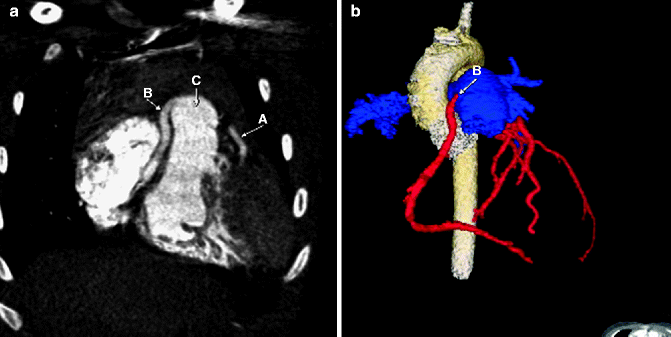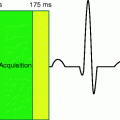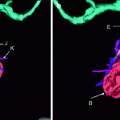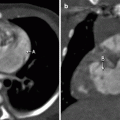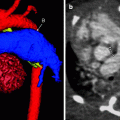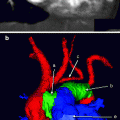Fig. 8.1
Color-coded three-dimensional (3D; a) and axial maximum-intensity projection (MIP; b) images from a patient with normal anatomy. The right coronary artery (C) arises normally from the right coronary sinus (A). The left coronary artery (B) arises normally from the left coronary sinus. The left coronary artery divides into the circumflex artery (D) and the left anterior descending coronary artery (LAD; E)
ALCAPA
ALCAPA (anomalous left coronary artery from the pulmonary artery) is a coronary artery anomaly in which the left coronary artery arises from the pulmonary artery. It leads to cardiac ischemia and infarction, poor left ventricular function, and mitral valve regurgitation. The ischemia typically is a result of a steal phenomenon as the blood is shunted away from the heart to the low-pressure pulmonary artery system through the anomalous coronary artery. Patients with ALCAPA present in infancy with nonspecific symptoms, such as irritability, wheezing, and failure to thrive. The diagnosis usually is made by echocardiography, although cardiac CTA may be used in difficult cases. Findings consist of decreased left ventricular function, an anomalous origin of the coronary artery, and potentially enlarged collateral vessels. ALCAPA may be an isolated finding or may occur with other congenital heart anomalies. Surgical treatment involves either direct transfer of the left coronary artery to the aorta or bypass grafting.
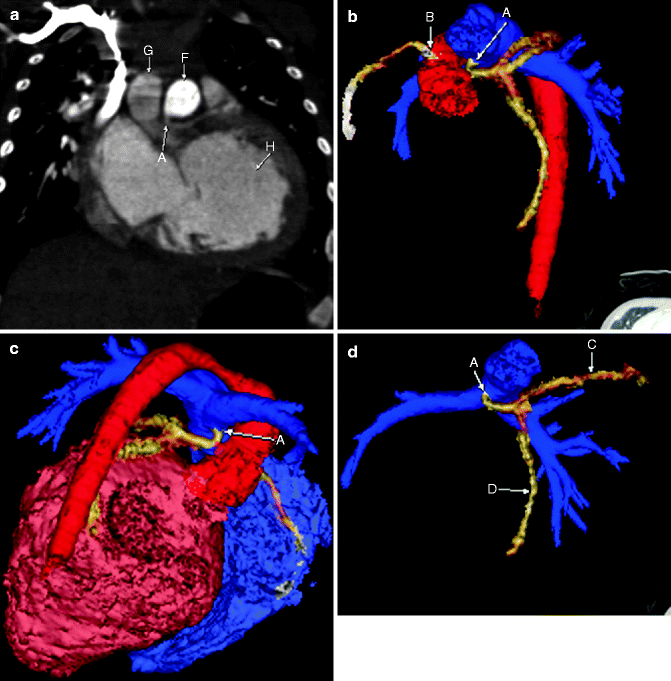
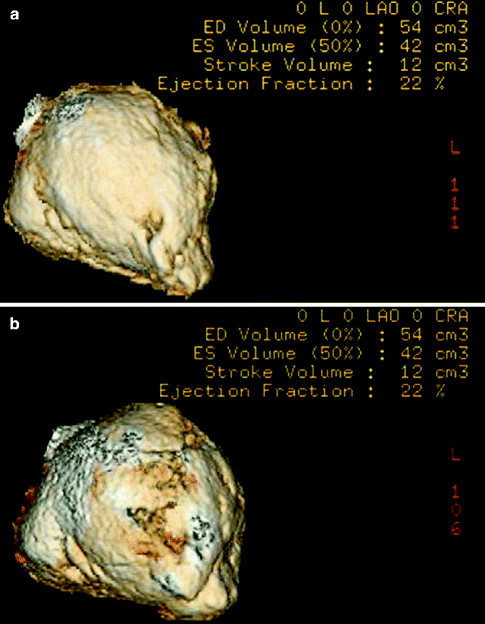

Fig. 8.2
Coronal MIP image (a) and color-coded 3D reconstructions (b–d) showing the left coronary artery (A) arising from the pulmonary artery (F, blue). The left coronary then branches normally into the LAD (C) and circumflex (D) arteries. The right coronary artery (B) is noted to originate normally from the aorta (G, red). Notice the dilated left ventricle (H)

Fig. 8.3
End-systolic (a) and end-diastolic (b) images from volumetric analysis in a patient with ALCAPA showing a markedly decreased ejection fraction of 22 % and a very dilated left ventricle. The heart failure develops from a steal phenomenon as flow in the anomalous left coronary flows toward the low-pressure pulmonary artery, stealing blood from the heart
Anomalous Right Coronary Artery from the Pulmonary Artery
Anomalous right coronary artery from the pulmonary artery (ARCAPA) is a rare coronary artery origin anomaly in which the right coronary artery arises from the pulmonary artery. As in ALCAPA, patients may present with a variety of nonspecific signs and symptoms, such as heart failure, angina, and myocardial infarction. Cardiac CTA may be used to demonstrate the anomalous origin of the artery. Coronary artery anomalies may be an isolated finding or may be associated with other anomalies. It is important to identify associated defects for surgical planning. Surgical treatment involves either direct transfer of the artery to the aorta or bypass grafting.
